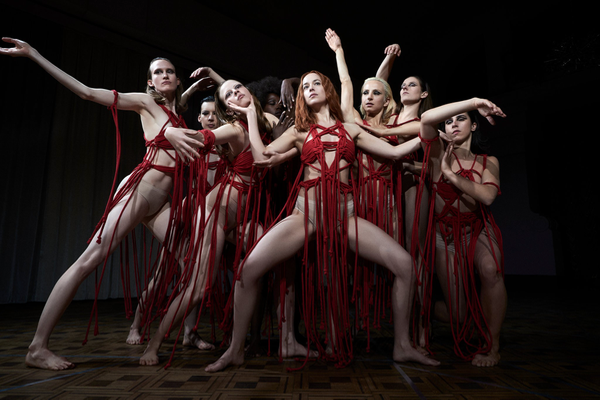Movie review by Greg Carlson
WARNING: The following review reveals plot information. Read only if you have seen “Suspiria”
Luca Guadagnino’s ambitious reimagining of Dario Argento’s “Suspiria,” the first installment of the cult director’s Three Mothers trilogy, honors its inspiration with shocking spasms of gore and mind-bending phantasmagoria. Expectedly, Guadagnino also approaches the remake with carefully considered storytelling, stretching the 1977 film’s 98-minute running time to a near miniseries length of just over two and a half hours. Argento’s version, based in part on Thomas De Quincey’s 1845 essay “Suspiria de Profundis,” stirs together Jungian symbolism and Grimm fairytale to create something original. The 2018 model, in its own way, is just as unique.
Dakota Johnson takes on the Jessica Harper role of Susie Bannion, an American dancer thrilled to join the prestigious Markos Academy in West Germany. Susie’s seeming naivete will yield to unexpected perceptions, and as “The Marriage of Heaven and Hell” portended, our youthful innocent will travel a road of excess all the way to the palace of wisdom. Or is it the audience navigating that rough terrain? Guadagnino, working from David Kajganich’s script (their previous collaboration, “A Bigger Splash,” was also an update: Jacque Deray’s “La Piscine”), radically reworks the central character, luxuriating in a series of climactic shocks that some fans of the original will dismiss and others will applaud.
Johnson, who appeared in “A Bigger Splash,” has more to do in “Suspiria,” but the film’s workhorse is Guadagnino favorite Tilda Swinton. Matching Peter Sellers’ “Dr. Strangelove” hat-trick, Swinton takes on reserved choreographer/master manipulator Madame Blanc, the physically decaying Mother Markos, and — under another heavy layer of mostly convincing prosthetic makeup — Dr. Josef Klemperer, the movie’s other (actual?) protagonist. Klemperer, the psychoanalyst who investigates the troupe following the disappearance of a dancer in his care, is certainly the most pronounced departure from Argento’s tale. Swinton as an elderly gentleman fits the warped vibe of sharp silver hooks and secret passageways; it’s the straightforward use of the Holocaust as narrative shorthand that doesn’t fully connect.
And how could Guadagnino possibly hope to compete with Goblin’s score? Thom Yorke, naturally, whose melancholy contributions to the new “Suspiria” are a perfectly haunting complement to Guadagnino’s gray-skies vision of chilly, rainy, Cold War Berlin. Goblin’s sounds, as Philip Sherburne recently noted, “Shovel[ed] all manner of seemingly incompatible ideas into the blender — Baroque harpsichords, synthesizers, tabla, splatter funk, even intimations of death metal.” Yorke, subdued, minimal, and ghostly, proves one of Guadagnino’s most fortuitous additions without sounding anything like Goblin, even though, as Sherburne points out, the influence of their central theme is respectfully quoted.
Like Manohla Dargis, I questioned the value of what she describes as the “ostentatious chapter breaks and narrative padding, including some dead-end references both to 1970s German politics (cue the tear gas, riots and Baader-Meinhof mentions) and, more egregiously, to the Holocaust.” The supernatural, notwithstanding some broad-brush aspects of gender thematizing that Dargis dismissively pegs as “the old vagina dentata scare show,” worked much better. As black sabbaths go, the competitive coven members in the new “Suspiria” put every move of their dance school disguises to potent use. Patient blood aficianados who stick with the filmmaker to the final reel will most certainly receive their crimson reward.
